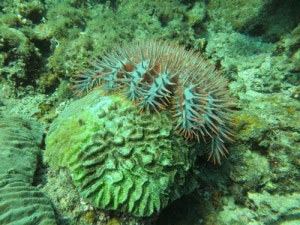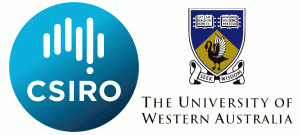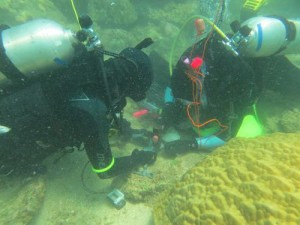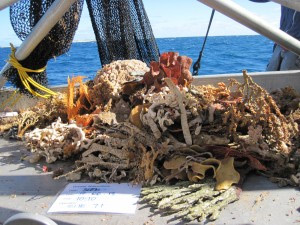Pilbara Marine Conservation Partnership

The remote west Pilbara region hosts high marine biodiversity. It contains three major marine parks including the World Heritage listed Ningaloo Marine Park.
The region is the focus for increasing tourism, and commercial and industrial activity that includes Australia’s largest LNG facility at Barrow Island.
This is first regional-scale assessment of marine biodiversity in the Pilbara. It will identify baseline information about the natural dynamics of the marine ecosystem, threats to sustainability, and the conservation needs of this unique environment. This research will inform management decisions that must balance conservation of the Pilbara’s diverse marine life with commercial interests for long-term sustainability.
Overview
 In partnership with The University of Western Australia (UWA), this project undertook the first regional-scale assessment of the Pilbara’s marine environment. This requires at least six major study locations between northern Ningaloo and the Dampier Archipelago, although more locations were sampled throughout the program.
In partnership with The University of Western Australia (UWA), this project undertook the first regional-scale assessment of the Pilbara’s marine environment. This requires at least six major study locations between northern Ningaloo and the Dampier Archipelago, although more locations were sampled throughout the program.
The comprehensive assessment provided baseline information on the natural dynamics of the west Pilbara’s ecosystems, including the health of coral reefs and the status of fish and shark assemblages, as well as defining environmental pressures and threats to marine biodiversity in the region.
This research has informed scientific models that are designed to help us understand how the whole ecosystem is interconnected and how well it can recover following impacts and natural disturbances, such as cyclones (more hit the west Pilbara every year than anywhere else in Australia).
Surveys were designed to allow us to identify thresholds that influence the condition of reefs and the associated plants and animals.
Ultimately, this comprehensive assessment will continue to inform management responses and complement existing governance arrangements needed for long-term management of the region.
PMCP partners continue to provide ongoing advice and assessment for conservation efforts in the region, ensuring that the five-years of PMCP research will provide long-lasting tangible benefits.
Download Report:
Pilbara Marine Conservation Partnership Annual report 2014-15 (274 KB, PDF)
The challenge

Marine environments are highly connected by both ocean currents and the movement of animals, so localised events that affect the health of coral and fish on one reef will impact other reef systems within the region.
Establishing a regional context is therefore particularly important, especially with respect to geographical gradients of coral and fish abundance along the coastline and the effects of regional environmental disturbances, such as coral bleaching events.
Before the PMCP’s detailed regional-scale assessment of the condition and long term dynamics of marine ecosystems of the Pilbara, it would have been difficult to detect or evaluate the resilience of the environment or to isolate the causes of localised changes.
Project aims
 CSIRO and UWA continue to work closely with state and regional agencies to provide information for planning, while linking into cycles of assessment, evaluation and management actions.
CSIRO and UWA continue to work closely with state and regional agencies to provide information for planning, while linking into cycles of assessment, evaluation and management actions.
Using scientific and social processes the PMCP research team:
- Undertook regional scale assessment of conditions of, and threats to, marine biodiversity;
• Evaluated the condition of coral reef ecosystems and fish and shark populations;
• Identified the most important processes driving variation in the ecosystem, to understand this variation in the context of natural and human-induced influences;
• Established benchmarks (i.e. points of reference against which to measure changes) and thresholds (i.e. points below which the ecosystem risks altering to an undesirable state).
This project will contribute to broader marine conservation outcomes by providing the data and information to establish an ecosystem-wide regional context for environmental and industry monitoring programs that will underpin marine management in the region.
Background
The Pilbara, well known for its natural environments, is also widely recognised for its red earth and its vast mineral deposits, in particular iron ore.
The region produces the majority of Australia’s domestic and exported oil and gas and its ports carry most of the nation’s iron ore exports.
The infrastructure supporting these and other industries is concentrated along the coastal fringe or in offshore facilities.
The area is also characterised by habitats of high ecological value, such as mangrove forests, seagrass beds, coral reefs, and sponge beds.
These habitats support a diverse fish community, as well as dugongs, turtles, whale-sharks, and a globally-significant fringing coral reef ecosystem.
Together these ecosystems are unique, because of their location along an arid coast that receives very little terrestrial runoff, thereby facilitating high coral growth exceptional for a continental margin.
This significance was recognized in 2011 with the listing of the Ningaloo coast by UNESCO as a World Heritage site.
Partnering for Impact
As institutions with multiple common interests and strong existing collaborations, CSIRO and UWA have joined together to deliver the project.
These two research institutions share multiple synergies and see the integration of expertise and knowledge as a wonderful opportunity to collaborate on this critically important research project.
